The Castle Cieszyn Design Centre (Zamek Cieszyn) design possibilities. Indeed, they are convinced that design is an effective tool for increasing the competitiveness of businesses, institutions, towns, cities and regions. They believe that design solves problems and designers can offer suggestions about transforming our closest surroundings in order to make our lives better. The Zamek is a great promoter of the idea of Design for All, which involves keeping physical, social and cultural differences in mind. Since 2010 they have been the home of the Professor Michał Oźmin Institute of Design for All and we are the custodians of the EIDD Design for All archive. They support any ideas which can improve the quality of public space and services.
Zamek Cieszyn -previously called the Silesia Castle of Art and Enterprise – is the name they have been using since January 2011 when they transformed the place into a centre of research and documentation into material culture and design.
Its focus on Poland this week, where the fabulous Human Cities partners Zamek Cieszyn are opening up for rather ambitious ideas to reconnect with the city’s history as a market town for the whole region.
Cieszyn is one of these intriguing Central European places that has changed national identity several times, even in recent history. So much so that in its current incarnation its state allegiance is divided between Poland and the Czech Republic The river flowing through the city marks the end of Cieszyn and the beginning of Český Těšín, as its called on the Czech side of the border.
As mind-boggling as the concept of a divided city is to someone who isn’t used to it, as completely mundane it is to the people living there. Thus, our Polish partners are casual about including the territory of two national states in their Human City.
Its about common spaces for inhabitants of the whole city, market stalls and meeting places playing in wonderful concert – opening night in the summer of 2016!
A social campaign for the return of empty buildings in Katowice city centre to urban life in Katowice, Poland
Fundacja Napraw Sobie Miasto (“Fix Your City” Foundation) addressed the issue of empty buildings in 2013, during the realisation of the project Vacant Central Europe: Mapping and recycling empty urban properties. This is when we mapped the empty properties from the social point of view and searched for ideas how to utilise them temporarily and permanently. In 2014, we took special interest in a particular object: the seat of Pracownia Projektów Budownictwa Ogólnego (General Construction Projects Studio) in the district of Koszutka, which used to be run by Henryk Buszko and Aleksander Franta, the authors of the legendary icons of modernism: Osiedle Gwiazdy (“Stars” housing estate) and Osiedle Tysiąclecia (“A 1000 years anniversary” housing estate) in Katowice as well as the health resort in the town of Ustroń. Moreover, we asked various people whether they knew any abandoned places in the city which could be used as interesting exhibition or theatre spaces. While seeking inspiration for a way to regulate the use of such places in the future, we came across a similar programme working in Warsaw. We started monitoring and assessing its effects.
Working on the Rent the Place DIY project we prepared the second edition of a spatial database and maps based on the detailed information obtained from Katowice City Hall. At the same time, we realised that the issue, however important, was barely present in the public debate, which was why we launched the social campaign. Therefore, the goal of our action is to draw the attention of the residents and users of Katowice urban space to the problem of vacant buildings, to promote the idea of the temporary use of uninhabited properties, and to generate and test the ideas for their reuse. This is the reason why we are running the informational campaign, building social support for the proposed legal solutions, collecting signatures under a petition, networking potential renters of the empty buildings, and organising workshops to demonstrate the possibilities of their adaptation.
Video: https://www.youtube.com/watch?v=nhvLum9GCs8
-Key-actors
Role of design
The whole project was run iteratively, and the idea emerged in the course of consecutive stages of development. After the completion of each stage, we organised retrospective workshops at which we verified and reformulated the adopted solutions and developed the rules for the invitation of new partners. This was why changed our initial idea.
The concept of the legal regulations was prepared according the service design method during a meeting of the project team. The social campaign and the action promoting the short-term rental of empty premises were developed in a workshop manner (co-design).
CONTACT
Organization: Fundacja Napraw Sobie Miasto
Email : agata.janko@naprawsobiemiasto.eu – kontakt@naprawsobiemiasto.eu
wep page: http://naprawsobiemiasto.eu/
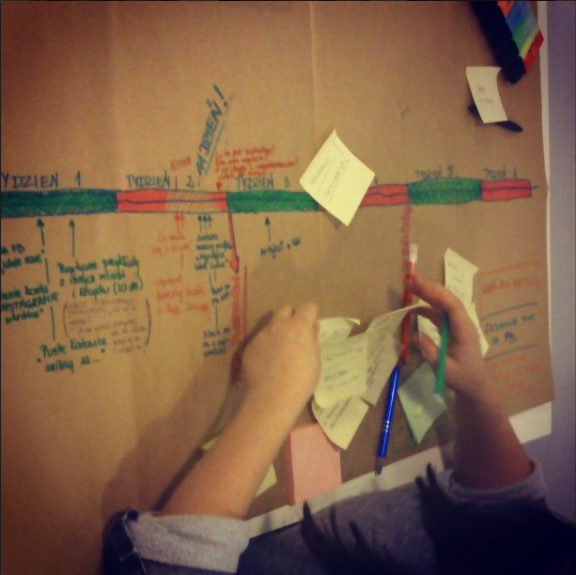
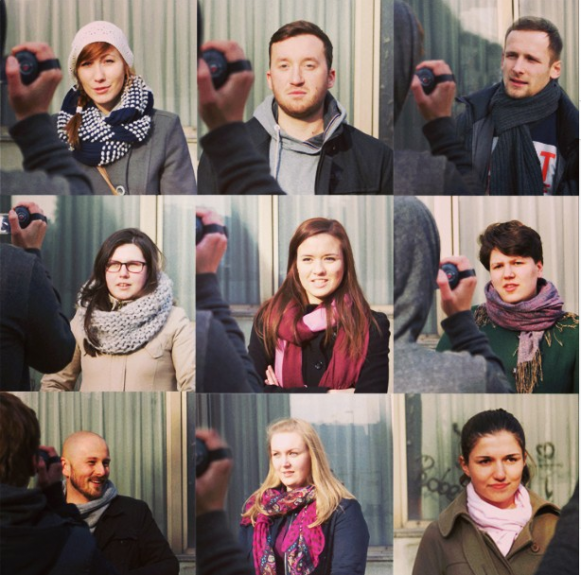
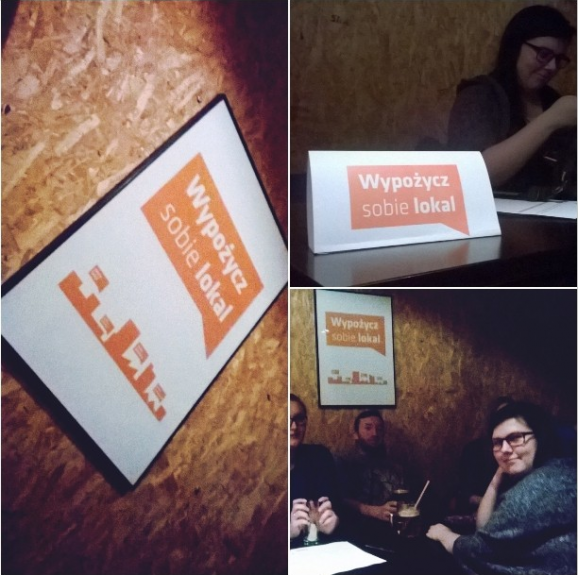
Since 2014, the Human Cities network has been working on Challenging the City Scale to question the urban scale and investigate cocreation in cities. The Human Cities partners have carried out urban experimentations in 11 European cities empowering citizens to rethink the spaces in which they live, work and spend their leisure time.
Challenging the City Scale, journeys in People-Centred Design is the final book of the project. Through conversations with people involved, the book examines how bottom-up processes and their design, tools and instruments generate new ideas to reinvent the city. It offers inspiration and insights to everyone, from practitioners and politicians to designers and active citizens, eager to try out new ways to produce more human cities together.
Title : Challenging the City Scale, Journeys in People-Centred Design
Collective book co-edited by: Olivier Peyricot, Josyane Franc, Frank Van Hasselt
Authors: Josyane Franc, Olivier Peyricot, John Thackara, Alice Holmberg, Côme Bastin, Fleur Weinberg, Anya Sirota, Frank Van Hasselt, Robin Houterman
Graphic design: Audrey Templier, Isabelle Daëron Language: English Publisher and distributor: Birkhäuser, Basel
Co editors : Cité du design (Saint-Etienne) et Clear Village (Londres) ISBN: 978-3-0356-1796-2 Format : 21,5 x 26 cm (vertical)– 176 p Price: 39.95 € Available in partner’s bookshops and bookshop distributed by Birkhäuser Open access digital version: https://www.degruyter.com/view/product/510323?format=EBOK
The printed version was launched on 4th May 2018 in Graz, during the event organized by FH JOANNEUM included in the programme of the Festival Design Month.
You can now download it in digital , open access version following this link:
01_human_cities_challenging_the_city_scale_2014-2018_investigation
The book “Investigation” is a collaborative research work, made from all the case studies collected by the partners in Europe publicated on this website. They tell about actions led by creative citizens to transform their urban environment. Researchers from Cité du design Saint-Étienne, the Department of Design of Politecnico di Milano and Urban Planning Institute of The Republic of Slovenia Ljubljana provide a state of the art of these initiatives. Analysing these multiple examples, they investigate how urban dwellers participate, get organized and collaborate with creative professionals to prototype more liveable cities.
This scientific work published by Cité du design Saint-Étienne is addressed to researchers, practitioners, but also developers or creative citizens.
It is both an object of Design research and an incentive to develop experimental and collaborative projects of urban transformation.
Title: Human Cities / Challenging the City Scale 2014-2018 / Investigation
Main authors:
Cité du design Saint-Etienne: Isabelle Daëron, Floriane Piat & Eléa Teillier
Design Departement, University Politecnico di Milano: Davide Fassi & Laura Galluzzo
Urban Planning Institute of the Republic of Slovenia, Ljubljana: Matej Nikšič, Nina Goršič & Biba Tominc
Language: English
Copyright © Cité du design, 2018
ISBN: 978-2-912808-79-0 . Format : 215×260 mm – 240 p – not sold – free distribution within the framework of Creative Europe Programme of the European Union 2014-2018
As cities organizations are facing major urban and technological transformations, European citizens are taking possession of their cities, collaborating or acting for its renewal. Which kind of tools are set up to think and produce the public space together? How to make these bottom-up initiatives sustainable?
Challenging the City scale 2014-2018 / Investigation is a collaborative research work of Human Cities project, made from more than 80 case studies collected by the partners in Europe. They tell about actions led by creative citizens to transform their urban environment. Researchers from Cité du design Saint-Étienne, the Department of Design of Politecnico di Milano and Urban Planning Institute of The Republic of Slovenia Ljubljana provide a state of the art of these initiatives. Analysing these multiple examples, they investigate how urban dwellers participate, get organized and collaborate with creative professionals to prototype more liveable cities.
This scientific work published by Cité du design Saint-Étienne is addressed to researchers, practitioners, but also developers or creative citizens.
Title: Human Cities / Challenging the City Scale 2014-2018 / Investigation Main authors: Cité du design Saint-Etienne: Isabelle Daëron, Floriane Piat & Eléa Teillier Design Departement, University Politecnico di Milano: Davide Fassi & Laura Galluzzo Urban Planning Institute of the Republic of Slovenia, Ljubljana: Matej Nikšič, Nina Goršič & Biba Tominc
Language: English Copyright © Cité du design, 2018 ISBN: 978-2-912808-79-0 . Format : 215×260 mm – 240 p – not sold – free distribution within the framework of Creative Europe Programme of the European Union 2014-2018
Projekt koncepcyjny Parku Kastanowego w Cieszynie – Conceptual project of Chestnut Park in Cieszyn
1. Exhibition:
17.07.2012 r. Cieszyn Castle took the opening of the exhibition “Where to play?” presenting playgrounds drawings made by children from the classes at the School of Painting, Drawing, Photography and Thinking located in Cieszyn. The exhibition was a pretext to discussion what and where to play in Cieszyn. Talks were attended by residents, representatives of the city and designers from the studio: pracownia k. The active participation of citizens and good will the city authorities resulted in another meeting – participatory workshops, routed a week later.
2. Workshop 22.07.2012:
Workshop with public consultation with residents of this district. Aim of the workshop was to identify the main directions for the management of the park area maroon, create a list of guidelines for designers, as well as ideas to improve the quality of the space that can be made in the near future, taking into account budgetary constraints.
The city authorities decided to create in the park, which was undeveloped space, a place friendly to residents.
Key-actors
Main promoters: Zamek Cieszyn and Cieszyn City Hall
Secondary players and beneficiaries of the initiative and their main roles: NGO’s and inhabitants of Cieszyn
Role of design
In the process was using design thinking methods, based on a deep understanding of the problems and needs of users. Created interdisciplinary team – look at the problem from many perspectives. Frequent experimentation and hypothesis testing – building prototypes and gathering feedback from users. Used a systematic approach to the process. Realization of the project was made by professional designers from design studio: pracownia k.
CONTACT (of the editor)
Anna Pilch – Organization : Zamek Cieszyn – Email : apilch@zamekcieszyn.pl
The printed version was launched on 4th May 2018 in Graz, during the event organized by FH JOANNEUM included in the programme of the Festival Design Month.
You can now download it in digital , open access version following this link :
01_human_cities_challenging_the_city_scale_2014-2018_investigation
The book “Investigation” is a collaborative research work, made from more than 80 case studies collected by the partners in Europe. They tell about actions led by creative citizens to transform their urban environment. Researchers from Cité du design Saint-Étienne, the Department of Design of Politecnico di Milano and Urban Planning Institute of The Republic of Slovenia Ljubljana provide a state of the art of these initiatives. Analysing these multiple examples, they investigate how urban dwellers participate, get organized and collaborate with creative professionals to prototype more liveable cities.
This scientific work published by Cité du design Saint-Étienne is addressed to researchers, practitioners, but also developers or creative citizens.
It is both an object of Design research and an incentive to develop experimental and collaborative projects of urban transformation.
A second book – addressed to a more general audience – will be released in September 2018 and presented in Tallinn during the Desainiöö festival.
The book arrived freshly printed in Ljubljana on 20th April and it will be launched in Graz on 4th May 2018.
After a great work of case studies collection by all the Human Cities partners, a deep process of analysis by Cité du design, Politecnico di Milano and UIRS, and a nice graphic design elaboration by Audrey Templier, the scientific publication of Human Cities-Challenging the City Scale is released.
Its title: Human Cities / Challenging the City Scale 2014-2018 / Investigation
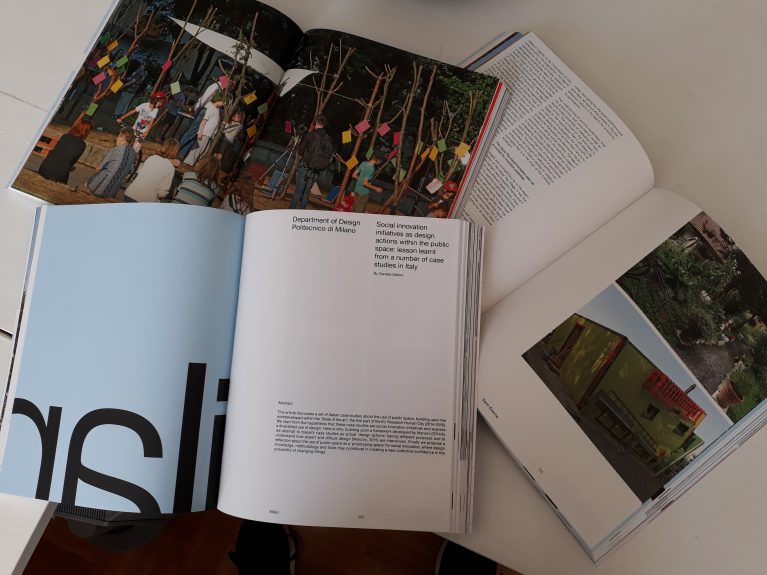
Glimpse of the book, fresh from the print shop in Ljubljana
As cities organizations are facing major urban and technological transformations, European citizens are taking possession of their cities, collaborating or acting for its renewal. Which kind of tools are set up to think and produce the public space together? How to make these bottom-up initiatives sustainable?
This Investigation is a collaborative research work, made from more than 80 case studies collected by the partners in Europe. They tell about actions led by creative citizens to transform their urban environment. Researchers from Cité du design Saint-Étienne, the Department of Design of Politecnico di Milano and Urban Planning Institute of The Republic of Slovenia Ljubljana provide a state of the art of these initiatives. Analysing these multiple examples, they investigate how urban dwellers participate, get organized and collaborate with creative professionals to prototype more liveable cities.
This scientific work published by Cité du design Saint-Étienne is addressed to researchers, practitioners, but also developers or creative citizens.
A large space is dedicated to images, to illustrate concretely this multiple initiatives, all linked by the sense of human scale and collaborative activities.
Our Investigation is both an object of Design research and an incentive to develop experimental and collaborative projects of urban transformation.

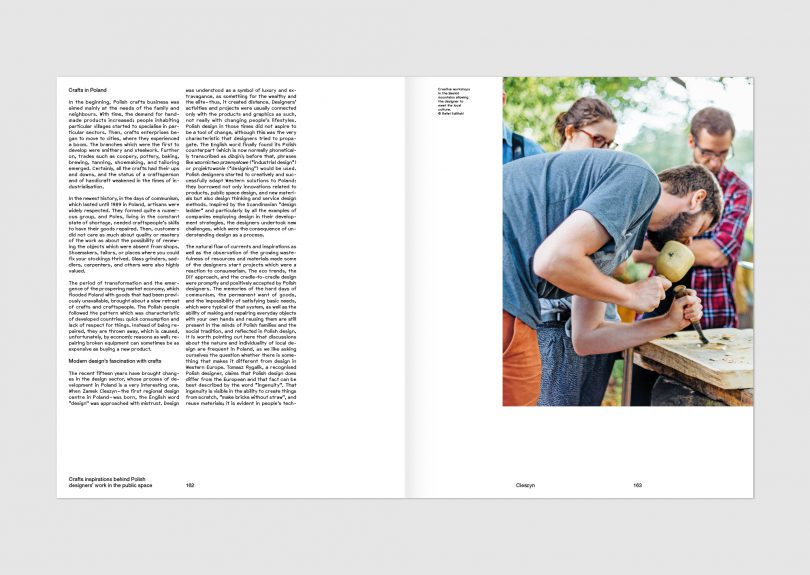
The book will be launched on 4th May in Graz for the 10 th festival Design Monat, during the event organized by FH JOANNEUM in presence of all the European partners of the programme. From this day, it will be available in digital version on the Human Cities project website – Case Studies section- and Cité du design Saint-Étienne website – publication section.
This is one of the common productions of the European project Human Cities_Challenging the City Scale . Together the partners will have produced 10 urban experiments in the various partner cities ; an exhibition-lab programmed in the main European Design festivals (next steps: Graz, Design Monat : 4thMay-24th June 2018 and Tallinn, Disainiöö: 10th– 16th September 2018) ; 11 international workshops ; masterclasses ; conferences ; and a final book narrating this experience (released in September 2018).
The experimentations in Cieszyn aim to improve an old part of the city as an opportunity for economic and cultural development with its various stakeholders and beneficiaries.
The design and concept for this app – which will be available to download from April 2016– was developed by three creative minds from Graz. Miriam Derler, Andrea Hutter and Miriam Weiss, all of them master students of Communication Design at the University of Applied Sciences, designed an interactive exhibition catalogue where users stand in the spotlight. The main idea was to create a catalogue, which you can not only browse but also be part of yourself. Therefore, all visitors of exhibitions have the possibility to upload their pictures, videos and remarks, which can then be seen in the app and on video screens in public space. In addition, a scan function allows participants to retrace authors of pictures as well as to leave comments. So everybody can be part of the app and the whole Human Cities Community. Due to this fact, a good mix of many different perspectives from various people can arise since everybody has a different design approach. With this app, the three designers successfully managed to connect the digital with the real world.
So participate yourself! Download the app in April and enjoy!
On 13th September 2018 , during the final event of Human Cities_Challenging the City Scale in Tallinn, happy partners launched a very important common production : the human cities 2014-2018 project book : Challenging the City Scale, journeys in People-Centred Design.
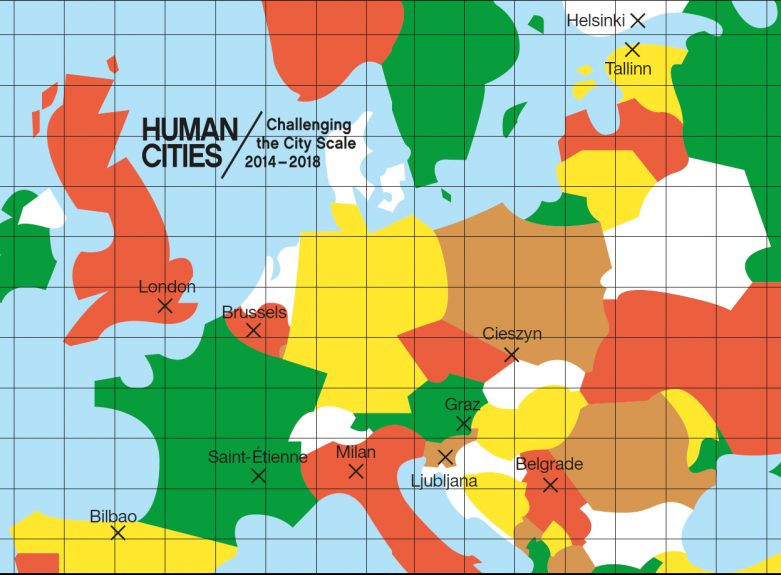
This 176 pages book is released by the famous international publisher Birkhäuser, and co-edited by Cité du design Saint-Etienne and Clear Village London, with the contributions of all the partners and invited authors. After a 1st publication oriented on research and inspirational case studies, this final book is the story of our experiences and cooperation addressed to a large audience of people interested in urban design and practices .
Since 2014, the Human Cities network has been working on Challenging the City Scale to question the urban scale and investigate cocreation in cities. The Human Cities partners have carried out urban experimentations in 11 European cities empowering citizens to rethink the spaces in which they live, work and spend their leisure time. Through conversations with people involved, the book examines how bottom-up processes and their design, tools and instruments generate new ideas to reinvent the city. It offers inspiration and insights to everyone, from practitioners and politicians to designers and active citizens, eager to try out new ways to produce more human cities together.
Our project can be seeen as a journey in people-centred design.
To prepare it, we asked Alice Holmberg, a designer and co-creation expert, to help each partner start their experiment through co-creative sessions. She explains in her article her approach to participatory design, and how she established a co-creation framework that was applied in a variety of contexts.

After the co-creative sessions, each partner departed on their own journey. For example, our partners in Saint-Étienne, Graz, Bilbao, Helsinki and London worked with citizens to turn vacant or
underused spaces into test sites for new solutions for work, service provision, education and communication. In Ljubljana, Belgrade, Cieszyn, Tallinn, Brussels and Milan, our partners joined forces with citizens to contribute to the development of a neighbourhood through improving the quality of public spaces. We invited two journalists, Côme Bastin and Fleur Weinberg, to capture the stories of the experiments in each of the 11 partner cities. These stories compose the main part of this book.

The variety of experiments allowed us to learn from each other. It also gave some hints for citizens, designers, and decision makers (insitutions and developers) which would like initiate that kind of actions. These learnings are shared in the third part of the book, written by Robin Houterman from a collective reflection led by all the partners.

We asked two urban experts to provide a context for our stories. John Thackara, a writer-philosopher, explains the importance of understanding the notion of the city “as a living system”. His chapter emphasises the need to take care of our commons, a term that includes the spaces, memories, knowledge, skills, culture and biodiversity that we all share.
Anya Sirota, founder of and architect at Akoaki, shares with us her experiences from Detroit, USA. In a context of severe urban decline, Akoaki designs architectural interventions, art objects,
and social environments that aim to make an impact far beyond their physical appearances.
As a conclusion – or an introduction to the next journeys to come – Olivier Peyricot and Josyane Franc re-question the topic of bottom-up initiatives in the global context of city making. Could active citizen be the sole driving forces of the tranformations in contemporary cities? How to collectively take responsibility and act for the global challenges facing our urban societies ?
Since its start, the Human Cities project has led to a network of “Human Citizens” distributing their knowledge and skills across Europe, and beyond as well by making use of the network of UNESCO Creative Cities of Design. By writing this book, we hope to expand this network of Human Citizens even further. We hope that by sharing our enthusiasm and experiences, the book will be an inspiration and a valuable reference for those inclined to become involved themselves. Moreover, we want to convince policy and decision makers of the value of these initiatives and inspire them to take action to facilitate them better in the future.
Ogródki bez granic – Garden without borders
http://www.laja.pl/fundacja-laja/
In the current society young people are more and more attached to social media communication losing their connections in real life. Also their activity within the field of active citizenship moves to the platform of social media. The aim of this project is to make its beneficiaries realize that the pursuit for the common goal can establish much stronger and lasting relationships that might be acknowledged many years after the project is finished. The participants will together create community gardens to meet their need to learn about ecology, establish a connection with the nature, need for work with the natural materials, ensuring the sustainable living, ability to respect nature, waste less and recycle more. The community gathers to create their own gardens, to plan and to get involved in the activities around the gardens. They maintain the garden. They participate in the educative lectures where they learn what is the community garden, how to create it, how to maintain it. The participants are involved in creating the gardens which will give them the opportunity to learn manual skills. After gaining these skills beneficiaries can inform other people in their community and spread the information about the urban community gardens and involve other citizens in similar activities. Throughout these activities they will show that they can actively and reasonably spend their free time involving their local community in the activities and at the same time contribute to it by changing the urban space to a green oasis giving more than added value in the form of fruits and vegetables.
Key actors
The main promoters of the project are local NGO’s that together agreed on creating and realisation of the project. Secondary players and beneficiaries together with the main promoter play main roles. Promoters together with beneficiaries decided on the design of the community garden, planned the activities and realized the idea by their own means. The project stressed the importance of three level cooperation between the Local government, third sector and the citizens.
Role of design
We have invited an Professional team Pracownia K. from Cracow to help us design the space according to the needs of participants and aims of the projects. It is a couple that specializes in natural design within urban context. They made workshops for the project participants based on the analysis of their needs. After the analysis they organized workshops which helped the participants to suggest their own vision of the urban garden. With the help of the Pracownia K. participants designed their vision of the garden. Later these ideas were put together to the complex project.
CONTACT (of the editor)
Mariola Kluzova – Organization : Fundacja Laja – Email : kluzova@smok.askcr.cz
She is the co-initiator and director of a unique design center as Zamek Cieszyn (the Castle Cieszyn). This is the place where you manage to combine design, innovative entrepreneurship and new technologies together with history and traditional craft. But since 2013 she is also the President of EIDD – Design for All Europe.
DAY 2: Saturday/ 27.01.2018
10.00–15.00 // Talks and workshops: Conflict resolution tools
Location: Zamek Cieszyn
10.00–11.30 //Ann Stenros, Chief Design Officer of the City of Helsinki
11.30–13.00 // Workshops lead by Jarosław Gwizdak, Rafał Kołodziej, and Monica Biagioli
14.00–15.00 // Talk by Monica Biagioli, London College of Communication
15.00 // Opening of Graduation Projects exhibition
16.00// Laugher yoga session
Location: Zamek Cieszyn
DAY 1: Friday/ 26.01.2018
16.00 // Opening of Human Cities Exhibition Challenging the City Scale
Location: Border guards building on a Friendship Bridge
17.00–19.00 // Conference: Design & Conflict
Location: Zamek Cieszyn
17:00–17:15 // Welcome word: Ewa Gołębiowska, director of Zamek Cieszyn
17.15–17.30 // Introduction: Monika Klonowska, psychologist, a coach and a consultant
17.30 // Debate with; Rafał Kołodziej, specialist in design thinking, value co-creation and innovation, Monika Klonowska, psychologist, a coach and a consultant, Paweł Jaworski , architect , “Fix your city” coordinator , a specialist in urban design and Jarosław Gwizdak, judge, chairperson from a district court.
19.00 // Conclusion by Tadeusz Sławek, poet, translator, essayist, professor of comparative literature
The first co-creation briefing of Human Cities in Cieszyn – Challenging the City Scale took place on the 9th-11th of November 2015.
The meeting was devoted to the centre of Cieszyn, where we want to perform our experiment. This part of the city is full of historical buildings, small shops and service outlets, artisan workshops, restaurants and cafés, which are all centred around the main street. Sadly, over a dozen such places have disappeared in the recent three years. Our experiment is meant to improve the image of the main street and some of the surrounding premises, to make the space more attractive and lively, to encourage people to spend their time in the area.
Thanks to our cooperation with Alice Holmberg and with our partner – Stanisław Brzozowski Association, actively supporting the social revival of the city – we had a chance to reflect together on the possible solutions for Cieszyn historical centre. For us, the co-creation session meant three days of intensive work on creative innovations for Cieszyn.
Cieszyn is a small town with an old historical centre. This part of the town is full of historical buildings, small shops and service outlets, craft workshops, restaurants and cafés, which are all located along the main street. Sadly, more than a dozen of such places have disappeared over the past three years. So the first natural choice in the Human Cities project was to focus on the revitalization of the old town. We had an idea to build installation-seats inspired by local avant-garde stories. However, life had its own scenario. It was not an easy decision to change the main topic of our action, but the primary rule is to observe and follow people’s needs. When you observe them and then react, it improves your chances of building a real human city.
Bus station
The reconstruction of the train and bus station brought about a new challenge. There was a need to find temporary solutions in the city until the new station opens in 2018. A new location for the station was proposed – it was comfortable for travellers but definitely not comfortable for the residents and the conflict soon broke out in the city. In this difficult situation the team of the Human City project discovered that the problem could be turned into an opportunity for the town to improve the quality of the service.
We got involved in the organization process of a temporary bus station. This meant cooperating with a big group of different participants: local government, transport companies, passengers of all ages and professions, small local business, etc. We started with designing visual communication for the temporary “Bus station”, than we moved on to the bus stops’ surroundings. We prepared a new timetable, built some furniture, planted flowers and provided some books. We tried to make the place as “human” as possible.
The temporaty „Bus Station” is located close to Zamek Cieszyn, so the work around it has become our daily experience and joy. We are happy to run the Human Cities experiment close to real people’s needs. And more importantly, our municipality has decided to build an original visual information system for the tourists and residents.
She is a project manager but also a craft&design specialist. She is now the Coordinator of projects focused on social innovations and participation. Engaged in contacts with the Czech Republic, Slovakia and Hungary.